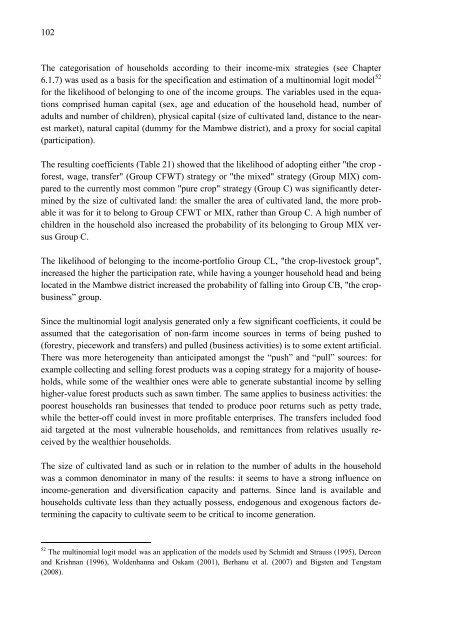Rural Income Generation and Diversification - A Case Study ... - Doria
Rural Income Generation and Diversification - A Case Study ... - Doria
Rural Income Generation and Diversification - A Case Study ... - Doria
You also want an ePaper? Increase the reach of your titles
YUMPU automatically turns print PDFs into web optimized ePapers that Google loves.
102<br />
The categorisation of households according to their income-mix strategies (see Chapter<br />
6.1.7) was used as a basis for the specification <strong>and</strong> estimation of a multinomial logit model 52<br />
for the likelihood of belonging to one of the income groups. The variables used in the equations<br />
comprised human capital (sex, age <strong>and</strong> education of the household head, number of<br />
adults <strong>and</strong> number of children), physical capital (size of cultivated l<strong>and</strong>, distance to the nearest<br />
market), natural capital (dummy for the Mambwe district), <strong>and</strong> a proxy for social capital<br />
(participation).<br />
The resulting coefficients (Table 21) showed that the likelihood of adopting either "the crop -<br />
forest, wage, transfer" (Group CFWT) strategy or "the mixed" strategy (Group MIX) compared<br />
to the currently most common "pure crop" strategy (Group C) was significantly determined<br />
by the size of cultivated l<strong>and</strong>: the smaller the area of cultivated l<strong>and</strong>, the more probable<br />
it was for it to belong to Group CFWT or MIX, rather than Group C. A high number of<br />
children in the household also increased the probability of its belonging to Group MIX versus<br />
Group C.<br />
The likelihood of belonging to the income-portfolio Group CL, "the crop-livestock group",<br />
increased the higher the participation rate, while having a younger household head <strong>and</strong> being<br />
located in the Mambwe district increased the probability of falling into Group CB, "the cropbusiness”<br />
group.<br />
Since the multinomial logit analysis generated only a few significant coefficients, it could be<br />
assumed that the categorisation of non-farm income sources in terms of being pushed to<br />
(forestry, piecework <strong>and</strong> transfers) <strong>and</strong> pulled (business activities) is to some extent artificial.<br />
There was more heterogeneity than anticipated amongst the “push” <strong>and</strong> “pull” sources: for<br />
example collecting <strong>and</strong> selling forest products was a coping strategy for a majority of households,<br />
while some of the wealthier ones were able to generate substantial income by selling<br />
higher-value forest products such as sawn timber. The same applies to business activities: the<br />
poorest households ran businesses that tended to produce poor returns such as petty trade,<br />
while the better-off could invest in more profitable enterprises. The transfers included food<br />
aid targeted at the most vulnerable households, <strong>and</strong> remittances from relatives usually received<br />
by the wealthier households.<br />
The size of cultivated l<strong>and</strong> as such or in relation to the number of adults in the household<br />
was a common denominator in many of the results: it seems to have a strong influence on<br />
income-generation <strong>and</strong> diversification capacity <strong>and</strong> patterns. Since l<strong>and</strong> is available <strong>and</strong><br />
households cultivate less than they actually possess, endogenous <strong>and</strong> exogenous factors determining<br />
the capacity to cultivate seem to be critical to income generation.<br />
52 The multinomial logit model was an application of the models used by Schmidt <strong>and</strong> Strauss (1995), Dercon<br />
<strong>and</strong> Krishnan (1996), Woldenhanna <strong>and</strong> Oskam (2001), Berhanu et al. (2007) <strong>and</strong> Bigsten <strong>and</strong> Tengstam<br />
(2008).

















